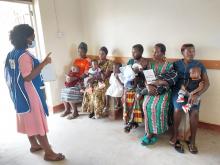Routine Yellow Fever Vaccination for Children taking shape in Uganda
Two hundred kilometers from Uganda’s capital Kampala lies Bukakata sub-county in Masaka district. Located along the shores of Lake Victoria, the sub county is one of the areas that reported a case of yellow fever in 2022 through the sentinel surveillance system.
The laboratory confirmed case scared community members, fearing the disease would spread among the largely mobile fishing community. It took the joint effort of local leaders, village health teams (VHTs), and health workers to contain the situation. The efforts included promoting health seeking behaviour and addressing the myths and misconceptions about the disease.
“Many people in the community attribute diseases like yellow fever to witchcraft,” says Edward Mayanja, the public health officer for Bukakata sub-county, adding that this complicates supportive interventions.
Yellow fever is transmitted to humans, from monkeys, by the Aedes Aegypti mosquito mainly in forested areas. It is then spread from human to human. Like other viral diseases, yellow fever has no specific treatment but is managed symptomatically (treatment of symptoms). Depending on the clinical manifestations, patients are treated for dehydration, liver and kidney failure, and fever among others. Associated bacterial infections can be treated with antibiotics.
Vaccination remains the most important means of preventing yellow fever. The yellow fever vaccine is safe, and affordable. A single vaccine dose provides life-long protection against yellow fever disease. The vaccine provides effective immunity within 10 days for 80–100% of people vaccinated, and within 30 days for more than 95% of people vaccinated. The yellow fever vaccine can be safely given to infants aged 9–12 months at the same time as the measles vaccine in yellow fever-endemic countries through the routine immunization program
Uganda is a high-risk country for yellow fever transmission due to less than 10 percent of the population being immunized against it, with sporadic outbreaks occurring every three to five years. Since 2010, Uganda has had several yellow fever cases reported. In 2022, there were two confirmed cases of yellow fever reported in Wakiso and Masaka districts.
With support from the World Health Organization (WHO), UNICEF, and Gavi, Uganda’s Ministry of Health is expected to immunize over 1.9 million children in 2023 with both yellow fever and measles-rubella vaccines. This is part of Uganda's commitment to the multi-stakeholder Eliminate Yellow Fever Epidemics (EYE) Strategy (2017-2026). Yellow fever vaccine is now available in all health facilities as part of the routine immunization program and provided for free to children aged nine months of age.
“In line with the EYE recommendations, I would like to commend the government of Uganda for successfully introducing the yellow fever vaccine into routine immunization since October 2022. This will boost the prevention and management of yellow fever in the country,” said Dr Yonas Tegegn Woldemariam, WHO Representative in Uganda.
In response to the yellow fever vaccine routine immunization rollout, parents in Bukakata sub-county are increasingly visiting Bukakata Health Centre III to have their children immunized. Immunization at the facility is done every weekday. An average of 15 children are immunized on the peak day (Wednesday). The immunization exercise involves administration of different vaccines, including yellow fever.
“We are convinced that in not more than five years, we shall have very few or no cases of yellow fever especially among children because all the past patients have been aged above 20 years,” explains Mayanja.
Initially, parents in areas around Bukakata Health Centre III were scared about taking their children to the health facility to be immunized because of misinformation, myths, misconception, and conservativeness. These have been addressed by raising public awareness.
“More parents are now bringing their children for immunization according to the routine schedule. When the parents come, we tell them about the yellow fever vaccine and its benefits. This has increased the numbers,” says Ritah Namanda, a nurse at Bukakata Health Centre III.
Josephine Nakavuma whose nine-month-old son received the yellow fever vaccine at Bukakata Health Centre III explains, “I am grateful to the VHTs and health workers for explaining to the community the benefits of immunizing our children against yellow fever. I also share this information with fellow parents I meet.”
WHO supports the training and deployment of Ministry of Health teams to manage yellow fever and conduct further investigations in affected districts to assess the risk and respond to future outbreaks.
Starting this year, Uganda will conduct a nationwide yellow fever preventive mass vaccination campaign targeting people aged nine months to 60 years in three phases to increase population immunity and eliminate yellow fever epidemics in Uganda. In the first phase (9-13 June 2023), 13.4 million doses of the yellow fever vaccine will be administered in six regions (Kabale, Kabarole, Lira, Arua, Gulu and Hoima) covering 51 districts. The goal is to eliminate yellow fever outbreaks in Uganda by 2026.
Communications Associate
WHO Uganda Country Office
Email: afwcougcom [at] who.int (afwcougcom[at]who[dot]int)
Phone: +256740487734
Communications Officer
WHO Uganda
Email: tcheutchouae [at] who.int (tcheutchouae[at]who[dot]int)




